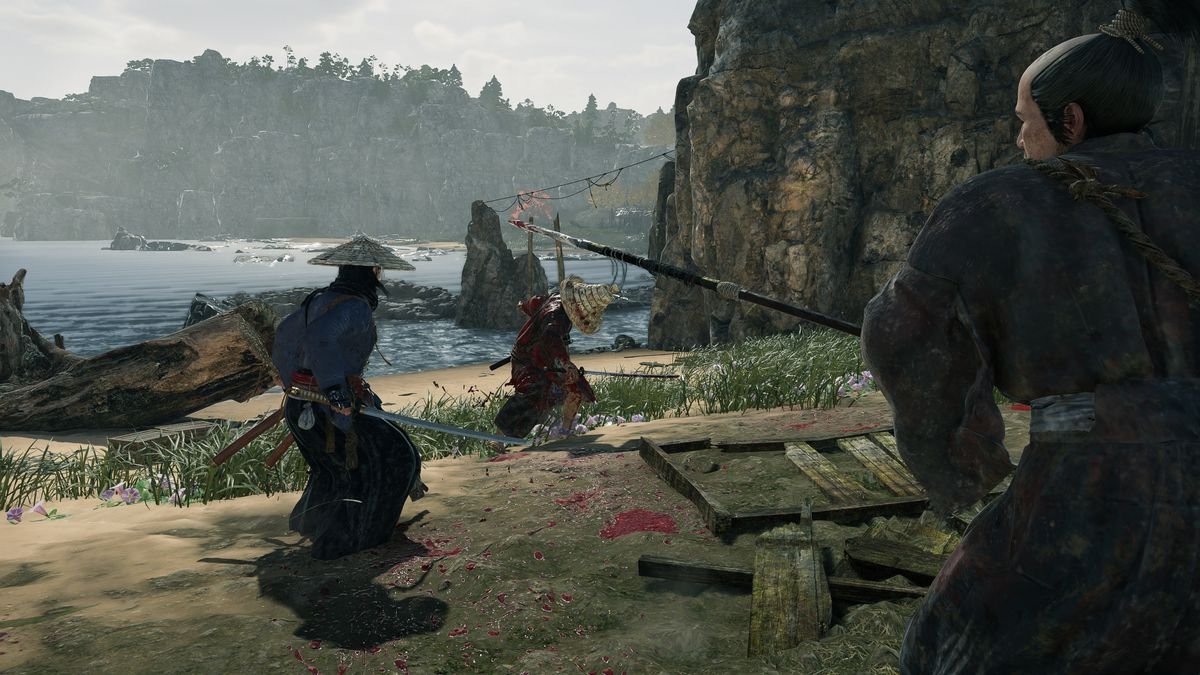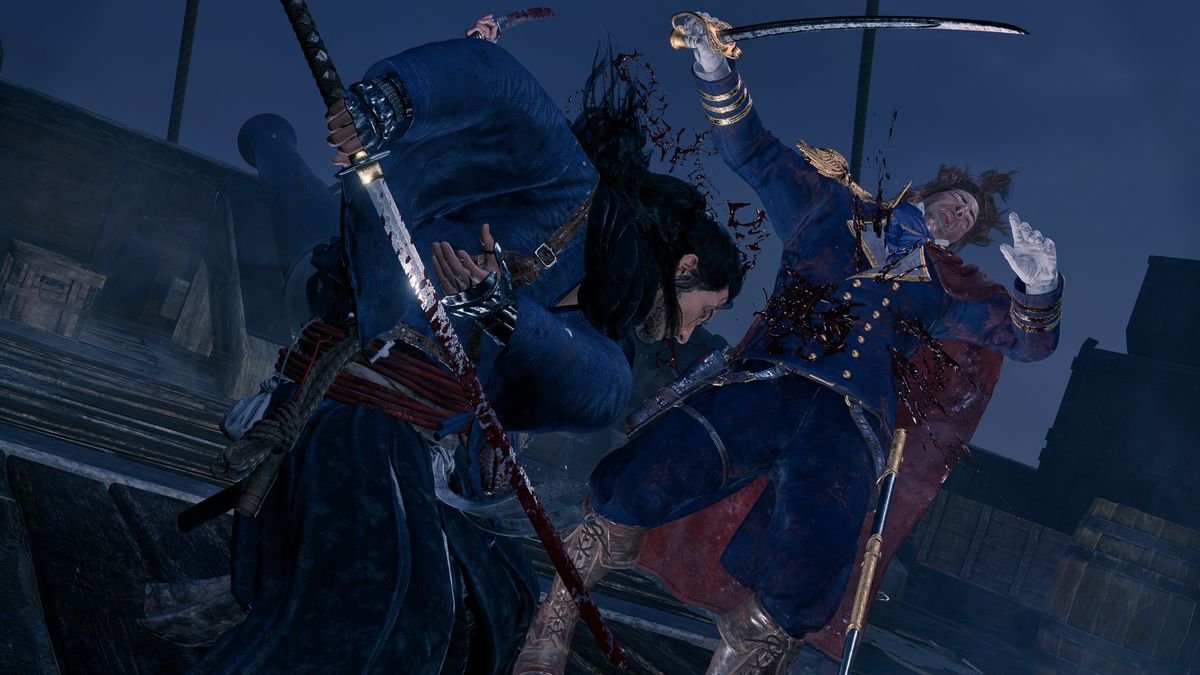Stalking through the neglected ruins of an empty graveyard, I crouched through a hole in a wall with my katana in hand, ready to strike. I was about a dozen hours into my playthrough of Rise of the Ronin, the latest open-world action RPG from Team Ninja, and I’d already abandoned the beaten path of the game’s main quest to hunt down fugitives terrorizing the countryside.
I was closing in on my latest target, a notorious graverobber. I trained my sights on the body of a man slumped in a corner being ravaged by a pack of dogs. I didn’t fully understand what was going on until I heard a snarl from my periphery and the telltale sign of a life bar materializing across the top of the screen. Suddenly everything clicked into place: Holy shit, the graverobber wasn’t a man; it was a freakin’ rabid dog.
Rise of the Ronin is full of such surprises. Just when you think you’ve gotten ahold of everything it has to offer, the game introduces another curveball or a mechanic that organically builds on a preexisting one, offering a depth of variety that feels exciting yet seldom daunting. Coming off of the success of last year’s Wo Long: Fallen Dynasty and 2020’s Nioh 2, Team Ninja has taken its design philosophy of precision-based hack-and-slash combat and applied it to its most ambitious project yet: an open-world action adventure set amid the political tumult of 19th-century Japan, a period known as the Bakumatsu.

Image: Team Ninja/Sony Interactive Entertainment
Players assume the role of a “Veiled Edge,” a swordsman and assassin trained from youth by a village of anti-shogunate conspirators to fight alongside a partner known as their “Blade Twin.” Following a disastrous mission where the player is separated from their partner, your village is massacred by shogunate forces. Having no home to go back to, you become a ronin and embark on a quest to be reunited with your lost Blade Twin. From there, your journey takes you to the far corners of the country as you cross paths with an eclectic cast of characters, including historical figures like Ryoma Sakamoto and Marcus Samuel, each with their own stake in the future of Japan.
Rise of the Ronin’s gameplay feels as indebted to Team Ninja’s aforementioned forays into the Soulslike genre as it does to contemporary titles like Sekiro: Shadows Die Twice and Ghost of Tsushima. Players customize their Veiled Edge and their accompanying Blade Twin’s appearance before selecting their starting weapons and “blade sharpening” technique (i.e., beginning stat boosts). From there, the game introduces the fundamentals of its combat system and mechanics before you’re set loose to wander the plains of Japan as you please.

Image: Team Ninja/Sony Interactive Entertainment
There are four primary skill trees, each with its own selection of abilities oriented around strength, dexterity, charisma, and intellect. In addition, each weapon type that you encounter throughout Rise of the Ronin comes with its own unique movesets and up to three alternate combat stances, which can be unlocked through how frequently you use that weapon or learned from characters you meet throughout the game and forge a “bond” with over time.
As if all that weren’t enough, you also have a grappling hook, which can be used to scale buildings and rooftops via interactable perches, close the gap between yourself and adversaries mid-combat, or even throw objects at opponents. You can even unlock the ability to perform stealth kills, using the hook to hoist your enemies up and slit their throats without being detected. At one point, I was tasked with tracking down a pair of fugitives who were responsible for terrorizing a rural village. I can’t tell you how satisfying it was to get the drop on these villains, knowing that the last thing either of them would see was the business end of my hook.

Image: Team Ninja/Sony Interactive Entertainment
As you progress throughout Rise of the Ronin, you’ll encounter several enemy types of bandits, mercenaries, and naval officers, each with their own varying levels of difficulty respective to your own level. Players gain two types of experience: EXP, which applies to their overall level and base stats, and Karma, which can be redeemed for points that can be spent upgrading their various skills.
Karma is represented by a bar beneath the player’s EXP gauge, which is filled by successfully defeating enemies. Once the bar is filled, you can light any one of the Veiled Edge checkpoint banners scattered across the world to convert your Karma into points. Herein lies Rise of the Ronin’s Soulslike twist: If you’re defeated by an opponent in battle, all of your unredeemed Karma is lost and a “vendetta” is forged between you and that enemy. You’ll have one opportunity to regain your Karma by defeating that opponent, but if you lose, you lose all that Karma.
The combat itself is a blast, and the vendetta system is a big part of it. I can’t tell you how many times I’ve thrown myself at a group of bandits whose level outranked my own just so I could get my Karma back, switching my tactics up from crossing swords to ambushing my adversary from afar with a barrage of flaming arrows and rifle fire.

Image: Team Ninja/Sony Interactive Entertainment
One of the coolest elements of Rise of the Ronin’s combat is the Counterspark mechanic, an alternate attack that, when timed properly, allows the player to parry an opponent’s oncoming strike and momentarily put them off-balance. A single successful Counterspark parry can earn the player crucial seconds of reprieve when they’re on the back foot in battle, but a successive series of Countersparks will whittle away your enemy’s stamina, known as Ki, allowing you to perform a devastating attack that deals a hefty chunk of damage, if not outright killing your opponent.
That’s easier said than done, though. Executing a Counterspark parry is more complicated than simply pressing a button in time with an on-screen prompt. You have to anticipate your enemy’s movements, which vary depending on their respective weapon type and combat stance, and strike right before they land a blow. It’s difficult to master, but gratifying to pull off. You can even Counterspark parry incoming arrows and bullets, which, when done successfully, not only deflects the projectile but momentarily sets your bladed weapon on fire, offering a much-appreciated damage buff in the heat of combat. In action, it’s an exhilarating move that emphasizes Team Ninja’s inimitable talent for stylish swordplay.

Image: Team Ninja/Sony Interactive Entertainment
I haven’t even touched on the game’s divergent story system yet. Rise of the Ronin’s story unfurls into an elaborate tapestry of relationships, with each of the major characters you encounter offering their own unique missions that shape the course of the plot as a whole. You can choose to side with the anti-shogunate in their bid to repel the Black Ships of Commodore Matthew Perry from Japan’s shores, or you can cast your lot in with the shogunate as they continue their campaign to root out sedition and forge a pact with the American forces. Those “bonds” I mentioned earlier? Those have a direct impact on not just the combat styles you can learn, but also your ability to call for assistance in combat during missions or redeem discounts from the shops and merchants found throughout the world.
I’m about 25 hours into Rise of the Ronin and I feel like I’ve only just begun to grasp the enormity of what it has to offer. From striding through hillsides atop a galloping steed to soaring above Yokohama using a prototype wing glider, the game’s version of Bakumatsu-era Japan feels as boundless in scope as it is bountiful in possibilities. Rise of the Ronin is an adventure worthy of Team Ninja’s pedigree, and a world I enthusiastically look forward to losing myself in for many more hours to come.
Rise of the Ronin will be released March 22 on PlayStation 5. The game was reviewed on PlayStation 5 using a pre-release download code provided by Team Ninja. Vox Media has affiliate partnerships. These do not influence editorial content, though Vox Media may earn commissions for products purchased via affiliate links. You can find additional information about Polygon’s ethics policy here.

















































